Printing Inks Market Size
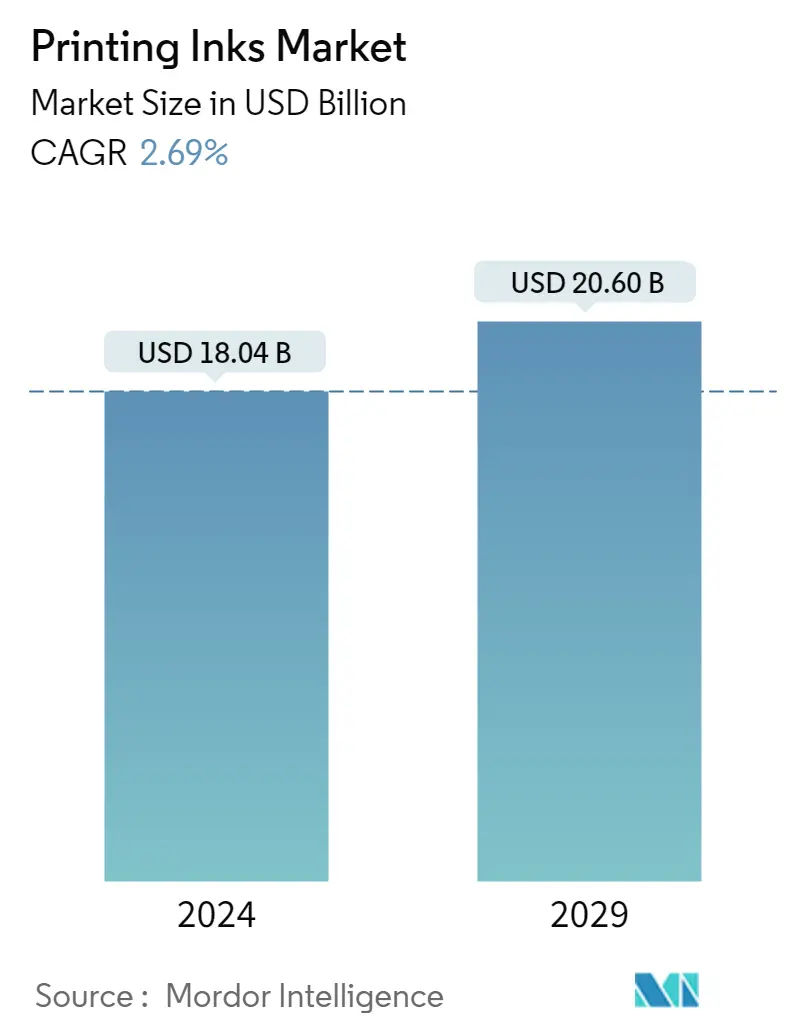
| Study Period | 2019 - 2029 |
| Market Size (2024) | USD 18.04 Billion |
| Market Size (2029) | USD 20.60 Billion |
| CAGR (2024 - 2029) | 2.69 % |
| Fastest Growing Market | Middle East and Africa |
| Largest Market | Asia Pacific |
Major Players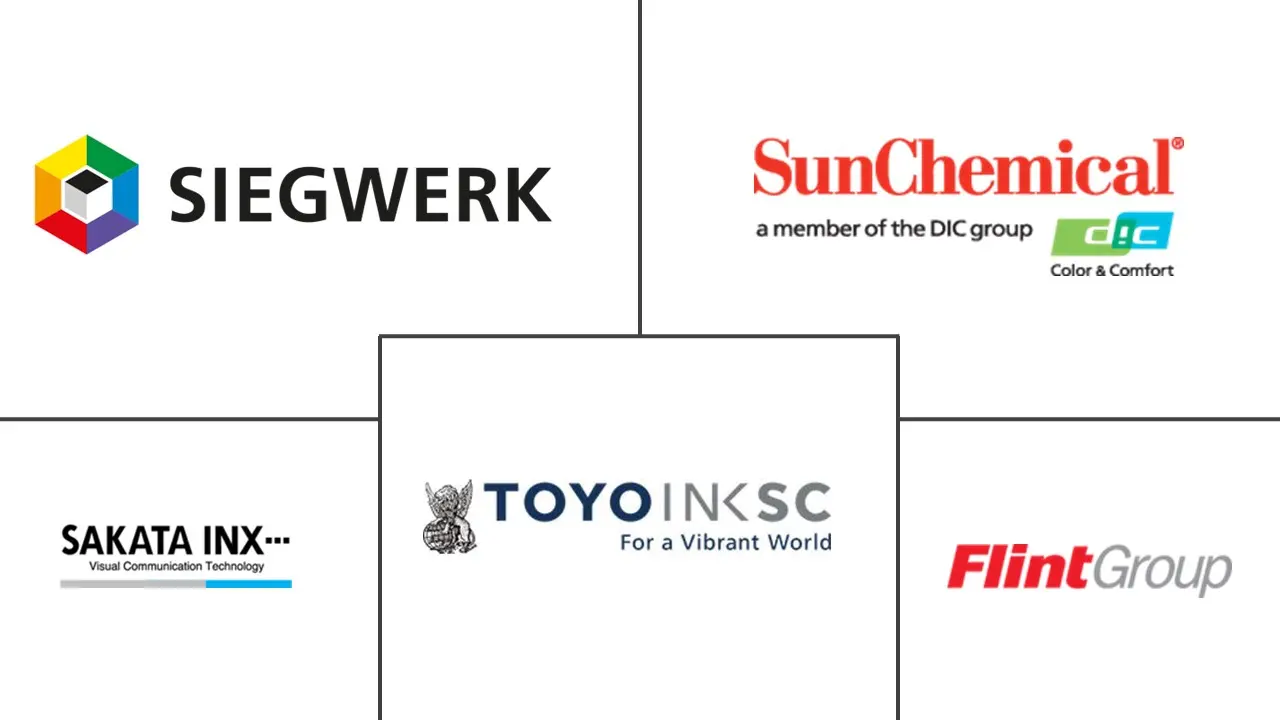
*Disclaimer: Major Players sorted in no particular order |
Printing Inks Market Analysis
The Printing Inks Market size is estimated at USD 18.04 billion in 2024, and is expected to reach USD 20.60 billion by 2029, growing at a CAGR of 2.69% during the forecast period (2024-2029).
Due to the COVID-19 impact in 2020, various manufacturing plants were shut down, and the demand for packaging has declined. Thus, this affected the consumption of printing inks in the packaging sector. However, the food and beverage industry started recovering and has shown a positive impact. In 2021 the industry was in the recovery process, and the manufacturers overcame many challenges that the pandemic created.
- In the short term, the major factors such as growing demand from the digital printing industry and the rising demand from the packaging and labels sector are expected to drive the market's growth.
- On the flip side, a decline in the conventional commercial printing industry, and stringent regulations regarding disposal are expected to hinder the growth of the market studied.
- Nevertheless, the emergence of bio-based and UV-curable Inks is likely to create lucrative growth opportunities for the global market soon.
- Asia-Pacific dominated the market across the world, with the largest consumption from China.
Printing Inks Market Trends
This section covers the major market trends shaping the Printing Inks Market according to our research experts:
Increasing Demand from the Packaging Segment
- According to a report published by PMMI, the Association for Packaging and Processing Technologies, growth in the global packaging industry is anticipated to reach USD 42.2 billion by 2021 from USD 36.8 billion in 2016. This is due to the increasing population, growing sustainability concerns, and more spending power in developing regions are expected to increase the demand for packaging.
- Digital printing is rapidly expanding into label production and electrophotography. The packaging industry is expected to experience a significant revolution over the next decade due to the increasing application of digital printing.
- Due to the quick turnaround capability that digital printing offers, it has been very popular among various brand owners. Recent developments in digital printing, such as digital carton cutting, creasing, and other completion technologies, have increased the potential for more applications in flexible packaging, corrugated packaging, and folding cartons.
- With the advantages of the inkjet process, such as being non-contact and low cost, this process is extensively used for printing large formats on a wide range of substrates, making it suitable for packaging. It can be integrated into existing conversion lines more efficiently than toner systems.
- With the developments in the food industry and the growing population in countries like China, India, and the United States, rigid packaging has been increasing over the past few years.
- Flexible packaging is the largest packaging application segment of the overall packaging market, owing to its various advantages, such as requiring 91% lesser material than rigid packaging, and about 96% of space saving. Moreover, with an increasing focus on sustainability, traditional rigid packaging solutions are being replaced by innovative and flexible packaging solutions.
- In the food industry, flexible packaging is preferred due to its moisture absorption properties, product freshness, and temperature control, while being able to maintain the shelf life of the product. Cigarettes and associated tobacco products are the major products for the flexible packaging industry, among other products, such as bottled water.
- In the food industry, flexible packaging is preferred due to its moisture absorption properties, product freshness, and temperature control, while being able to maintain the shelf life of the product. Cigarettes and associated tobacco products are the major products for the flexible packaging industry, among other products, such as bottled water.
- Hence, the demand for printing inks from the packaging industry is expected to grow at a rapid rate during the forecast period.
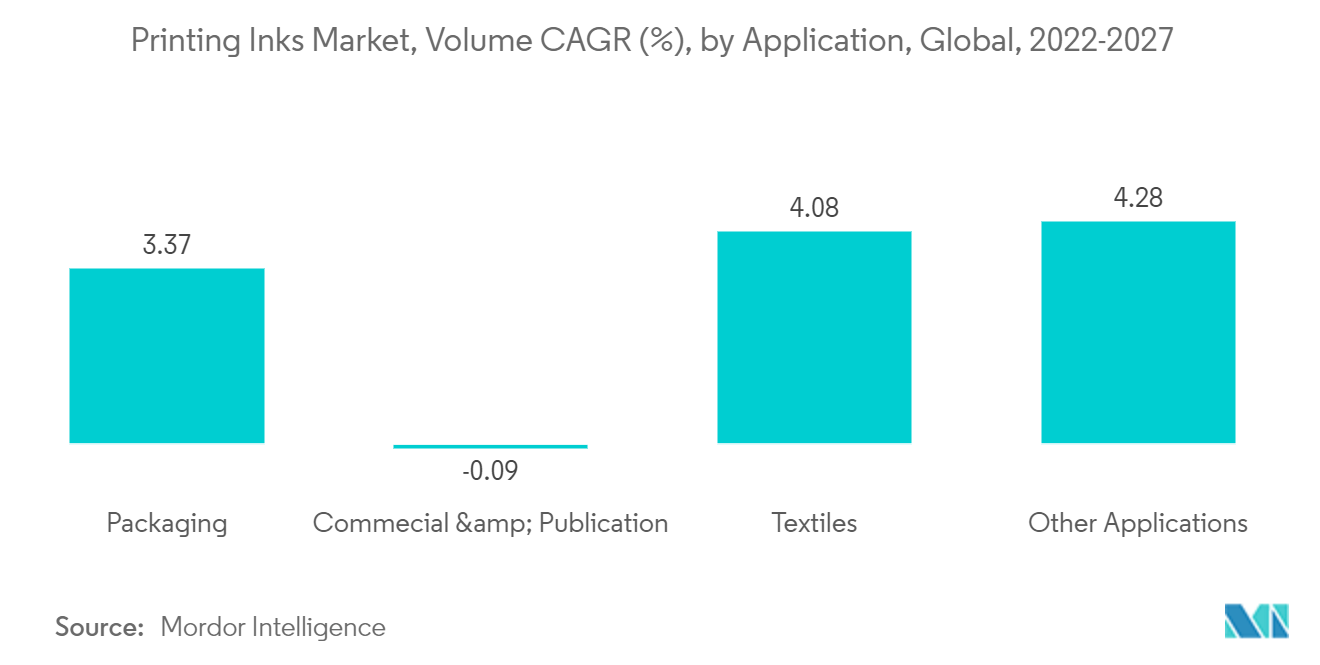
China to Dominate the Asia-Pacific Market
- The Asia-Pacific region dominated the global market share. With growing construction activities and the increasing demand for furniture
- China stands to be the world's largest manufacturing economy and exporter, due to which its packaging requirement is huge. The packaging industry in China produced 11.6 million metric tons million metric ton of packaging paper and paperboard in September 2022 and was the largest producer worldwide that year. China sees a growing trend in the use of flexible, rigid, and paper and board packaging materials. This positive momentum in the packaging industry is expected to boost the market demand for printing inks.
- Additionally, the packaging industry witnessed noticeable growth, with the increasing trend of express deliveries. the total volume of express delivery in China amounted to about 108 billion pieces in 2021.
- The textile industry in China employs millions of people and contributes significantly to the country's exports and economy. Chinese apparel cloth businesses are profitable and expanding, with the export sector experiencing day-to-day growth.
- In both the domestic and global consumer markets, the Chinese garment cloth industry is progressing in many areas, including raw material quality, industrial structure, modern high-tech machinery, label development, and the work process.
- Additionally, printing ink demand has also been increasing from the textile industry in the country. The country stands to be the largest clothing exporter in the world, holding massive production capacity, although the textile industry witnessed a slow growth in the past few years.
- Owing to all the above-mentioned factors, the market for printing inks in the region is projected to increase during the forecast period.
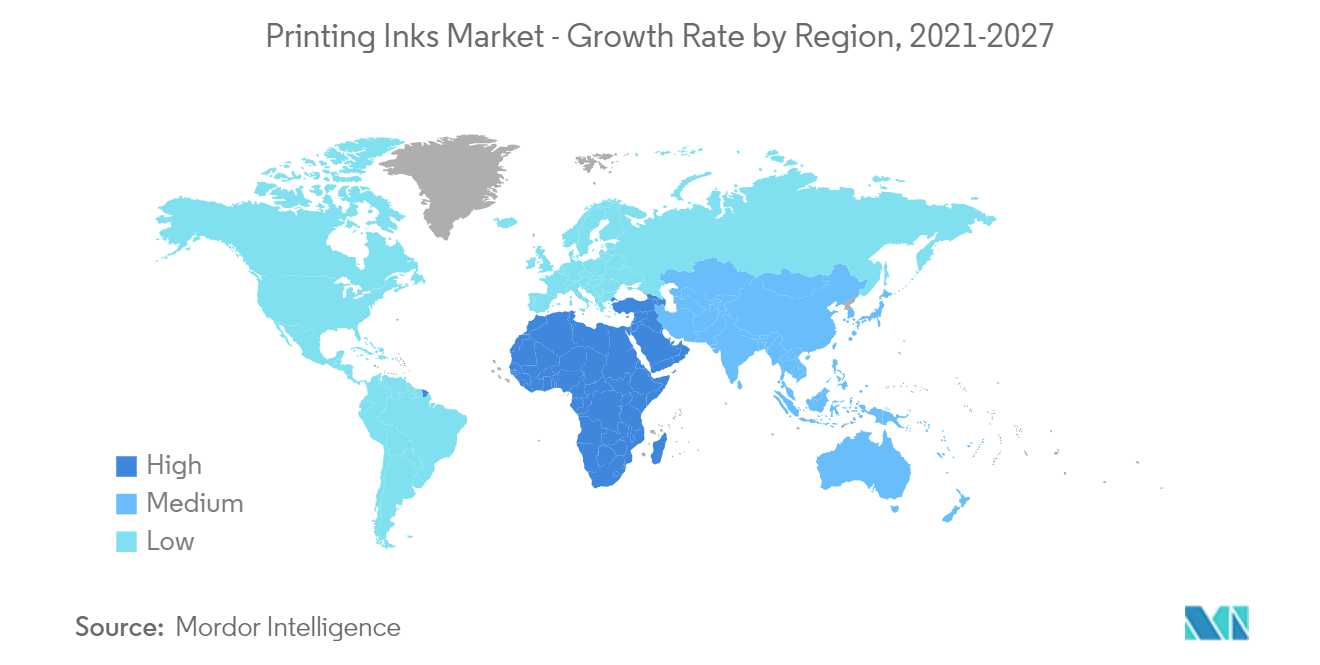
Printing Inks Industry Overview
The global printing inks market is partially consolidated, the top five players dominated the global market share. Some of the Major players include Sun Chemicals, Flint Group, Sakata Inx Corporation, Toyo Ink SC Holdings Co. Ltd, and Siegwerk Druckfarben AG & Co, among others
Printing Inks Market Leaders
-
Sun Chemical
-
Flint Group
-
Sakata Inx Corporation
-
Toyo Ink SC Holdings Co. Ltd
-
Siegwerk Druckfarben AG & Co. KGaA
*Disclaimer: Major Players sorted in no particular order
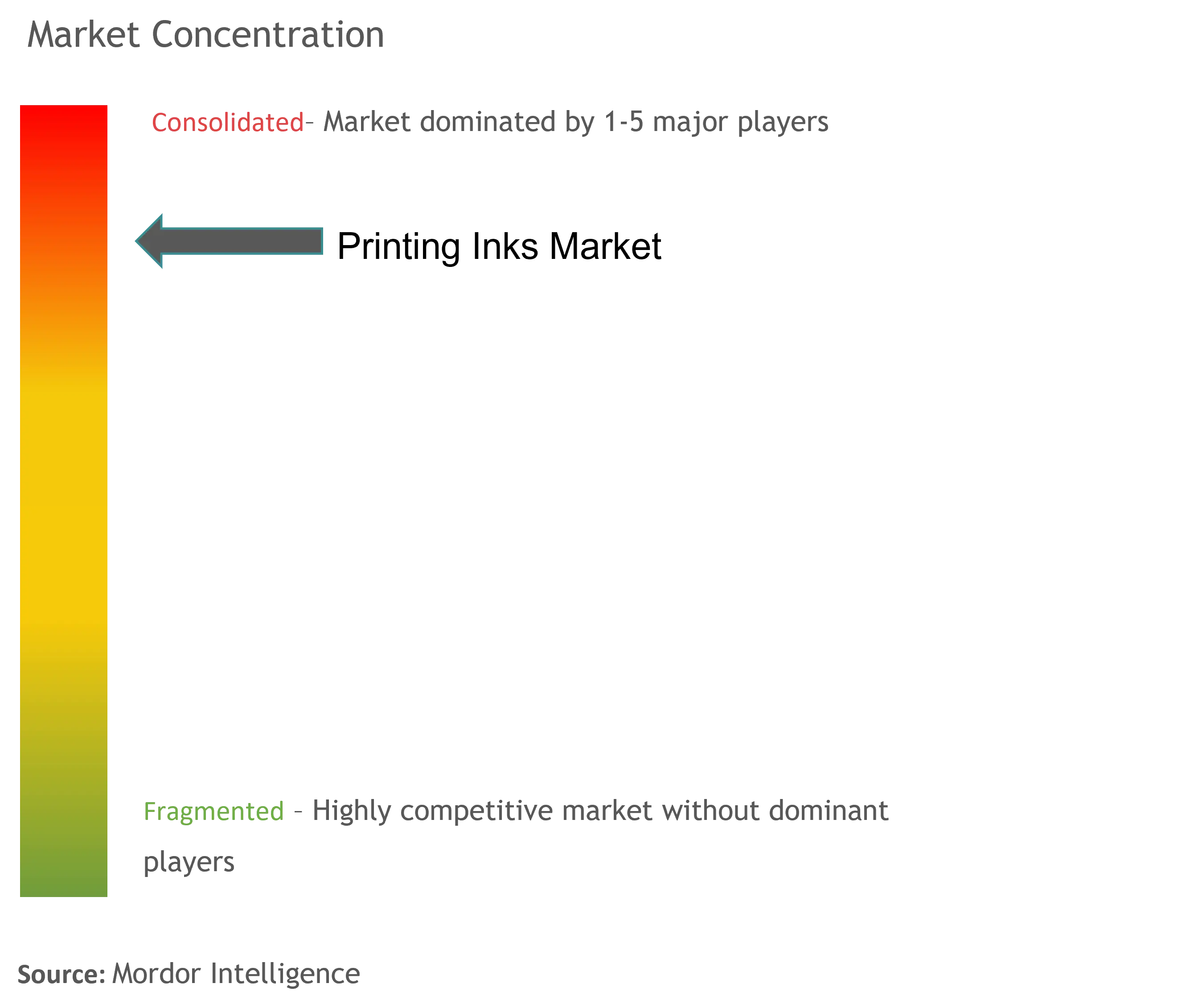
Printing Inks Market News
- On January 2022, Sun Chemical acquired SAPICI. strengthening supply strategy and adding capabilities to develop and create new polymers for the company's whole array of inks, coatings, and laminating adhesives.
- On January 2022, Encres DUBUIT acquired POLY-INK strengthening its product portfolio by adding conductive Inks. The company has combined nanomaterial scientific competence with application engineering capabilities through this acquisition.
Printing Inks Market Report - Table of Contents
1. INTRODUCTION
- 1.1 Study Assumptions
- 1.2 Scope of the Study
2. RESEARCH METHODOLOGY
3. EXECUTIVE SUMMARY
4. MARKET DYNAMICS
-
4.1 Drivers
- 4.1.1 Growing Demand from the Digital Printing Industry
- 4.1.2 Rising Demand from the Packaging and Labels Sector
-
4.2 Restraints
- 4.2.1 Decline in the Conventional Commercial Printing Industry
- 4.2.2 Stringent Regulations Regarding Disposal
- 4.3 Industry Value Chain Analysis
-
4.4 Porter's Five Forces Analysis
- 4.4.1 Bargaining Power of Suppliers
- 4.4.2 Bargaining Power of Buyers
- 4.4.3 Threat of New Entrants
- 4.4.4 Threat of Substitute Products and Services
- 4.4.5 Degree of Competition
5. MARKET SEGMENTATION (Market Size in Volume)
-
5.1 Type
- 5.1.1 Solvent-based
- 5.1.2 Water-based
- 5.1.3 Oil-based
- 5.1.4 UV
- 5.1.5 UV-LED
- 5.1.6 Other Types
-
5.2 Process
- 5.2.1 Lithographic Printing
- 5.2.2 Flexographic Printing
- 5.2.3 Gravure Printing
- 5.2.4 Digital Printing
- 5.2.5 Other Processes
-
5.3 Application
- 5.3.1 Packaging
- 5.3.1.1 Rigid Packaging
- 5.3.1.1.1 Paperboard Containers
- 5.3.1.1.2 Corrugated Boxes
- 5.3.1.1.3 Rigid Plastic Containers
- 5.3.1.1.4 Metal Cans
- 5.3.1.1.5 Other Rigid Packaging
- 5.3.1.2 Flexible Packaging
- 5.3.1.3 Labels
- 5.3.1.4 Other Packaging
- 5.3.2 Commercial and Publication
- 5.3.3 Textiles
- 5.3.4 Other Applications
-
5.4 Geography
- 5.4.1 Asia-Pacific
- 5.4.1.1 China
- 5.4.1.2 India
- 5.4.1.3 Japan
- 5.4.1.4 South Korea
- 5.4.1.5 Australia & New Zealand
- 5.4.1.6 ASEAN Countries
- 5.4.1.7 Rest of Asia-Pacific
- 5.4.2 North America
- 5.4.2.1 United States
- 5.4.2.2 Canada
- 5.4.2.3 Mexico
- 5.4.2.4 Rest of North America
- 5.4.3 Europe
- 5.4.3.1 Germany
- 5.4.3.2 United Kingdom
- 5.4.3.3 France
- 5.4.3.4 Italy
- 5.4.3.5 Russia
- 5.4.3.6 Spain
- 5.4.3.7 Rest of Europe
- 5.4.4 South America
- 5.4.4.1 Brazil
- 5.4.4.2 Argentina
- 5.4.4.3 Rest of South America
- 5.4.5 Middle East & Africa
- 5.4.5.1 Saudi Arabia
- 5.4.5.2 South Africa
- 5.4.5.3 Rest of Middle East & Africa
6. COMPETITIVE LANDSCAPE
- 6.1 Mergers and Acquisitions, Joint Ventures, Collaborations, and Agreements
- 6.2 Market Ranking Analysis
- 6.3 Strategies Adopted by Leading Players
-
6.4 Company Profiles
- 6.4.1 ALTANA
- 6.4.2 Dainichiseika Color & Chemicals Mfg. Co. Ltd
- 6.4.3 Dow
- 6.4.4 Epple Druckfarben AG
- 6.4.5 Flint Group
- 6.4.6 FUJIFILM Corporation
- 6.4.7 Hubergroup Deutschland GmbH
- 6.4.8 SAKATA INX CORPORATION
- 6.4.9 Sanchez SA de CV
- 6.4.10 SICPA HOLDING SA
- 6.4.11 Siegwerk Druckfarben AG & Co. KGaA
- 6.4.12 Sun Chemical
- 6.4.13 T&K TOKA Corporation
- 6.4.14 Tokyo Printing Ink Mfg Co. Ltd
- 6.4.15 Toyo Ink SC Holdings Co. Ltd
- 6.4.16 Wikoff Color Corporation
- 6.4.17 Yip's Chemical Holdings Limited
- 6.4.18 Zeller+Gmelin
- *List Not Exhaustive
7. MARKET OPPORTUNITIES AND FUTURE TRENDS
- 7.1 Emergence of Bio-based and UV-curable Inks
- 7.2 Other Opportunities
Printing Inks Industry Segmentation
Printing inks consist of a pigment or pigments of the required color mixed with oil or varnish, majorly a black ink made from carbon blacks and thick linseed oil added. The printing ink market is segmented by type, process, application, and geography. By type, the market is segmented into solvent-based, water-based, oil-based, UV, UV-LED, and other types of inks. By process, the market is segmented into lithographic printing, flexographic printing, gravure printing, digital printing, and other processes. By application, the market is segmented into packaging, commercial and publication, textiles, and other applications. The report also covers the market size and forecasts for the printing inks market in 19 countries across major regions. The report offers market size and forecasts for printing inks in volume (metric tons) for all the above segments.
| Type | Solvent-based | ||
| Water-based | |||
| Oil-based | |||
| UV | |||
| UV-LED | |||
| Other Types | |||
| Process | Lithographic Printing | ||
| Flexographic Printing | |||
| Gravure Printing | |||
| Digital Printing | |||
| Other Processes | |||
| Application | Packaging | Rigid Packaging | Paperboard Containers |
| Corrugated Boxes | |||
| Rigid Plastic Containers | |||
| Metal Cans | |||
| Other Rigid Packaging | |||
| Application | Packaging | Flexible Packaging | |
| Labels | |||
| Other Packaging | |||
| Application | Commercial and Publication | ||
| Textiles | |||
| Other Applications | |||
| Geography | Asia-Pacific | China | |
| India | |||
| Japan | |||
| South Korea | |||
| Australia & New Zealand | |||
| ASEAN Countries | |||
| Rest of Asia-Pacific | |||
| Geography | North America | United States | |
| Canada | |||
| Mexico | |||
| Rest of North America | |||
| Geography | Europe | Germany | |
| United Kingdom | |||
| France | |||
| Italy | |||
| Russia | |||
| Spain | |||
| Rest of Europe | |||
| Geography | South America | Brazil | |
| Argentina | |||
| Rest of South America | |||
| Geography | Middle East & Africa | Saudi Arabia | |
| South Africa | |||
| Rest of Middle East & Africa |
Printing Inks Market Research FAQs
How big is the Printing Inks Market?
The Printing Inks Market size is expected to reach USD 18.04 billion in 2024 and grow at a CAGR of 2.69% to reach USD 20.60 billion by 2029.
What is the current Printing Inks Market size?
In 2024, the Printing Inks Market size is expected to reach USD 18.04 billion.
Who are the key players in Printing Inks Market?
Sun Chemical, Flint Group, Sakata Inx Corporation, Toyo Ink SC Holdings Co. Ltd and Siegwerk Druckfarben AG & Co. KGaA are the major companies operating in the Printing Inks Market.
Which is the fastest growing region in Printing Inks Market?
Middle East and Africa is estimated to grow at the highest CAGR over the forecast period (2024-2029).
Which region has the biggest share in Printing Inks Market?
In 2024, the Asia Pacific accounts for the largest market share in Printing Inks Market.
What years does this Printing Inks Market cover, and what was the market size in 2023?
In 2023, the Printing Inks Market size was estimated at USD 17.57 billion. The report covers the Printing Inks Market historical market size for years: 2019, 2020, 2021, 2022 and 2023. The report also forecasts the Printing Inks Market size for years: 2024, 2025, 2026, 2027, 2028 and 2029.
What are the growth opportunities in the Printing Ink Market?
The growth opportunities in the Printing Ink Market are a) The growing demand for specialized printing inks in industries like automotive, electronics, and textiles b) Increasing focus on sustainability and the development of innovative ink formulations
Printing Ink Industry Report
The global printing ink market is experiencing significant growth, driven by various factors across multiple sectors and applications. The demand for printing inks is rising due to the need for visually appealing and informative packaging in industries such as food, beverages, and consumer goods. Additionally, there is a growing preference for sustainable and eco-friendly solutions, leading to the adoption of inks with lower VOC emissions, bio-based components, and water-based formulations. Digital printing technologies, including inkjet and UV-curable inks, are also contributing to market growth by enabling efficient short-run printing, customization, and faster production times. The UV curable segment is anticipated to register the highest growth rate due to its environmental benefits and superior print quality. The printing inks industry is characterized by a mix of established players and emerging companies, all striving to innovate and meet the evolving needs of various industries. Printing ink manufacturers are continuously developing new formulations to cater to the diverse requirements of their clients, ensuring that the print ink market share continues to expand. Statistics for the printing ink market share, size, and revenue growth rate, created by Mordor Intelligence™ Industry Reports, include a market forecast outlook and historical overview. Get a sample of this industry analysis as a free report PDF download.



